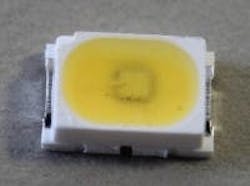Plessey ships a brighter GaN-on-Si mid-power LED
Plessey has announced the PLW114050 mid-power LED family with emitters available over the CCT range from 2700K to 6500K. The new products hit efficacy levels as high as 64 lm/W essentially doubling the performance of Plessey's first gallium-nitride-on-silicon (GaN-on-Si) LEDs shipped in April of this year, and moving the LEDs close to service in general solid-state lighting (SSL) applications.
The new LEDs are part of Plessey's Magic (Manufactured on GaN-on-Si I/C) portfolio. The company insists that manufacturing LEDs on low-cost, 6-in. Si wafers using depreciated and automated silicon IC fabrication facilities for the back end of the production process will yield lower LED prices. "Our Magic LED products have a cost advantage over comparable sapphire-based LEDs as we use 6-in., high yield, standard, automated silicon manufacturing technology," said Plessey CTO Keith Strickland.
Still, Plessey has yet to produce an LED with competitive performance specifications. Back at the April 2013 launch of the first-generation LEDs, efficacy topped out at 36 lm/W and maximum flux output was 3 lm. Subsequently, the company launched blue-pump LEDs for remote-phosphor applications in July with increased performance, but those aren't directly comparable because Plessey didn't announce a phosphor-converted white LED at the time.
The new white LEDs deliver flux ranging from 7.9–12.3 lm when driven at 60 mA. The typical forward voltage is 3.2V, which yields efficacy ranging from 41–64 lm/W. While doubling performance in just over six months is impressive, the products trail sapphire-based mid-power LEDs significantly. For example, Seoul Semiconductor announced slightly-larger mid-power LEDs back in July that can hit 180 lm/W at 60 mA.
Plessey, however, claims that it will continue to ramp performance and soon match sapphire LEDs. "We have a roadmap that puts Magic ahead of the efficacies achieved by sapphire-based LEDs and, thereby, sets a new milestone in terms of lumen per dollar performance," said Strickland. "By approaching efficacy parity, we are accelerating the widespread adoption of GaN-on-Si LED-based lighting products."
For now, the Plessey LEDs will be applicable primarily to decorative lighting, instrument panel backlighting, and signaling. But should Plessey double performance again inside eight months, and ship the products in volume, the SSL world will start to take notice.
